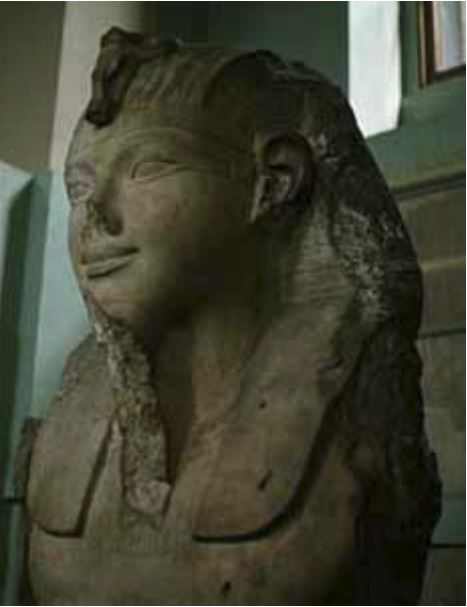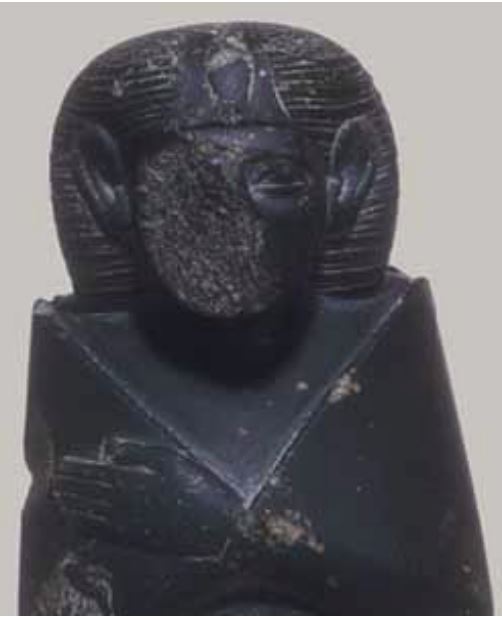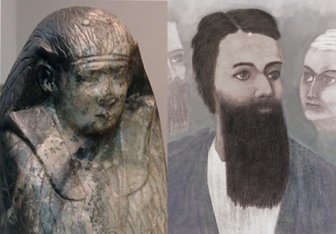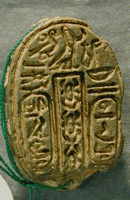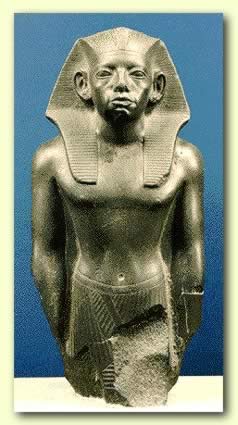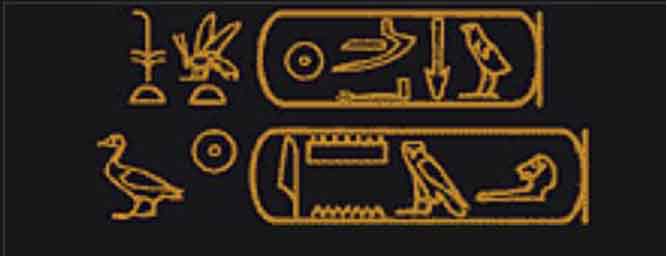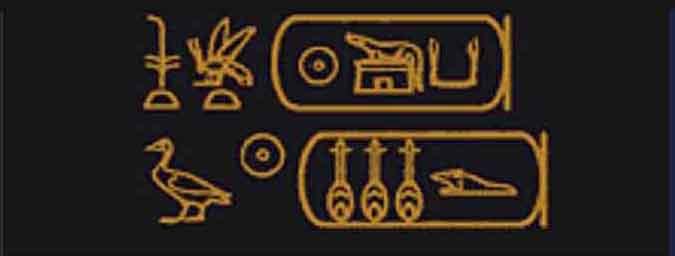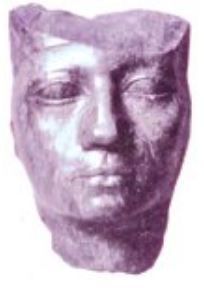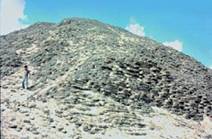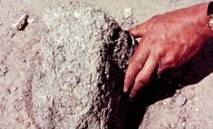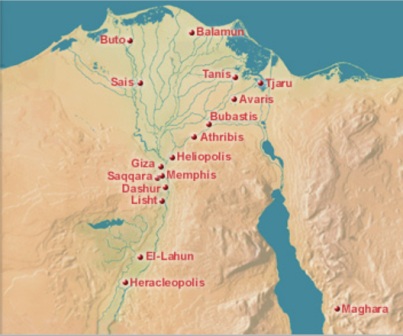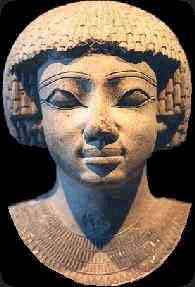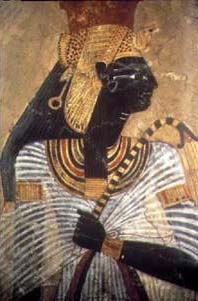Oahspe Study
THE EXODUS OF THE HEBREWS, MOSES AND THE PHARAOHS PART 9
Who was Moses, Pharaoh, Pharaoh's Daughter and Nu-ghan
|
|
The only surviving mortal accounts about Moses and the Exodus, within the context of the Israelites / Faithists in Egypt during the Middle Kingdom Period of Egypt, are in the Ezra bible and some ancient rock inscriptions. The Ezra Bible account, however, is filled with inaccuracies since it is the Egyptian account of the Exodus, written by the enemies of the Faithists. The few rock inscriptions are sparse and contested by scholars, most of whom prefer to think of the Exodus of the Hebrews as a myth. But since 1882, previously lost information now published in the book Oahspe, provides details about Moses and the Israelites, that can be verified in surviving ancient Egyptian records. This evidence shines a new revealing light upon history as most mortals know it today.
Pharaoh or King
Pharaoh
is the ancient Pheonician (Fonecian) word for Sun King, according to the
editor's footnote in Oahspe. But Egyptologists believe the term
"Pharaoh" was not used for Egypt's rulers until the 18th Dynasty,
which began with Ahmose I around 1550 bce. Because of this conventional etymology,
most biblical scholars consider the use of the term Pharaoh in the Ezra Bible
(Old Testament / Jewish Torah) account of the Exodus to be evidence that the
event occurred sometime after the establishment of the New Kingdom (1550 bce).
But the term "Pharaoh" in the Ezra Bible is not necessarily
an artifact of authorship within the actual historical period of the Exodus. It
is now generally accepted among biblical scholars that the Ezra Bible was
written many centuries after the event. And, according to Oahspe, the Ezra
Bible account was recorded more than a thousand years after the event (ca 494
bce (See Mythical Conquest of
Canaan). There are also numerous other terms and references in the
Ezra Bible that are prochronisms or anachronisms to the time period of certain
events and personages (for example, in Gen 11:28 and 31 "Ur of the
Chaldeans" are mentioned in the times of Abraham, however, Chaldeans were
not known in history until the times of Ashurnasirpal II or III ca 883-859
bce). But such misplacements of times and events can be expected once it is
understood that most of the Ezra bible was compiled and edited in the post
Babylonian period of the Jews by Ezra and his scribes around 495 bce.
Apparently, according to Oahspe's use of the term Pharaoh, it was known in
Egypt during the Middle Kingdom which ended around 1550 bce, at the time of
Moses. The Language Tree in Oahspe indicates that the Fonecian language was
flourishing long before Moses' time and, although it was known in Egypt before
1550 bce, it was not native to the Egyptians, but used by the ruling classes,
educated and scribes. Oahspe provides the context of how the Fonecian language
(which was developed among the traders and merchants that travelled the trade
routes connecting Egypt, the Mediterranean and East Asia) was used among the
Egyptians of Moses' time, being the last of the 12th Dynasty. Oahspe states
that Egypt had several languages at the time:
Oahspe, Book of the Arc of Bon, 27/14.2.
|| The languages of the learned [of Egypt] were Fonecean and Par'si'e'an; but the native languages were Eguptian, Arabaic, Eustian, and Semis. The times (calendar) of the learned gave two suns (365 days) to a year, but the times of the tribes of Eustia gave only six months to a year. ||
Many other details that were previously unavailable to mortal history are provided in Oahspe's account of the Exodus of the Hebrews, including detailed descriptions of and references to the four individuals: Moses, Pharaoh, his daughter Leotonas, and Nu-ghan, the pharaoh who resisted the Exodus of the Hebrews. This essential information connects surviving historical accounts and archaeological evidence in time and period context, cutting through existing confusion about historical events among Egyptologists and Biblical scholars. Details not known or recognized at the time that Oahspe was written have since come to light, highlighting Oahspe's remarkable foresight that anticipates future developments and discoveries by mankind beyond the time it was written. In this case, not only do the two Pharaohs of the Exodus emerge from what seemed like a lost history of the past, but Moses and his adoptive mother / sister, Leotonas also appear, with all the authority of the Pharaohs of Egypt!
The Correct Date for the Exodus and the Real Age of Moses
Oahspe unequivocally places the beginning of the Arc of Bon as 1550 bce, at which time Moses was about 40 years old. With the addition of four more years when the Israelites set foot on the eastern shore of the Red Sea, Moses' real age at the time of the Exodus was 44 years old. In contrast to the Ezra Bible account of the Exodus which gives Moses' age at the time of the Exodus to be 80 years old, Oahspe explains why the confusion and incorrect age recorded by the authors of the Ezra Bible.
Oahspe, Book of the Arc of Bon. 27/14.2-3.
|| .... The times (calendar) of the
learned gave two suns (365 days) to a year, but the times of the tribes of
Eustia gave only six months to a year. Accordingly, in the land of Egupt, what
was one year with the learned was two years with the Eustians and Semisians.
God said: My people shall reckon their times according to the place and the
people where they dwell. And this they did. Therefore, even the tribes of
Israel had two calendars of time, the long and the short.... ||
At 40 years old Moses was ready to begin working for the release of the Israelite Faithists from Egypt which took approximately four years. This confirms that the Faithist migration at the beginning of the Arc of Bon was around 1546 bce.
Oahspe, Book of the Arc of Bon. 27/15.24-25, 27/20.15.
|| When the three were alone that night, lo and behold, it was the beginning of the dawn of light. And Moses' ears were opened and he heard the Voice of Jehovih (through His angels) saying:
Behold, O king and you, Leotonas, and you Moses, now is the beginning of My power on the face of the earth. Moses, My son, you shall take your people out of the land of Egupt; and I will bestow upon them the lands of the ancients, even where I will lead you. Do not change your laws, O king; let Egupt have her way, and let the
Israelites have their way also. ||
|| At the time Moses reached Shakelmarath he was forty-four years old..... ||
The Oahspe account states that after the dawn of the Arc of Bon, Moses travelled with his brother, Aaron for 3 years, organizing and preparing for the Migration before he revisited the King, his adoptive father. The old king was ill and would not live much longer, but he lived on for at least another seven months during which time his commissioners surveyed and reported on the conditions of the lands where the Israelites would travel. After receiving the reports of Pharaoh's commissioners, Moses appointed a time for the migration. This means that the time from the beginning of the project, when Moses, his adoptive father and sister heard Jehovih's words, to the time that the succeeding Pharaoh came to the throne must have been four years, being just months before the appointed day for the migration to start.
Oahspe, Book of the Arc of Bon, 27/16.11-12.
|| Jehovih said: And the Heads shall have seventy-seven days notice; and they shall notify the rab'bah of their places, so that due preparation shall be made for the start. Nevertheless, the time appointed to your people shall be kept secret with the Heads and with the rab'bahs. And whatever number the rab'bah can send forth, he shall notify the Head; and when all things are ready, that number shall go forth on the day appointed, everyone on the same day.
And Moses appointed the tenth day of the month Abib, when all the people should start..... ||
|
TIMELINE OF EVENTS FROM MOSES' BIRTH TO THE EXODUS
|
DURATION |
DATE bce |
|
Birth of Moses
|
|
1590 |
|
Dawn of Arc of Bon
|
5 years, 40 days |
1550-1545 |
|
Moses travels to set on foot the migration
|
3 years |
1550-1547 |
|
Pharaoh appoints commission of inspectors
|
7 months |
1547-1546 |
|
Moses appoints migration date giving notice to family heads.
|
77 days (2.5 months) |
1547-1546 |
|
Time from when migration plan is set on foot to the time when the Red Sea is crossed
|
4 years, 207 days (7 months) |
1550-1546 |
|
Moses reaches Shakelmarath when he is 44 years old
|
|
1546 |
Who Moses and his Adoptive Royal Family were among the Pharaohs
Pharaoh ~ Moses' adoptive father, was the reigning ruler of Egypt with a grown daughter at the time of Moses' birth. This information indicates that he must have been on the throne for at least more than 44 years before he died around 1546 bce. Thus, a clue to his identity should be a lengthy rein prior to 1546 bce, at least as far back as 1590 bce. But in conventional Egyptian timelines there are no accounts of any pharaoh reigning anywhere near as long as that just prior to 1550 bce. The reason being that Egyptologists have erroneously identified an intermediate period, beginning with the so called 13th Dynasty and ending with the putative 17th Dynasty, thus misdating the whole Middle Kingdom period about 230 years too early.
But if we take our cue from Oahspe's account and place the end of the Middle Kingdom around 1550 bce, we find that the third last ruler of the 12th Dynasty of the Middle Kingdom, Amenemhat III, was allotted a reign of some 56 years, thus his reigning years fit with the pharaoh who was Moses' adoptive father.
Amenemhat III, was a pharaoh of the Twelfth Dynasty of Egypt....the highest known date [for his reign] being found in a papyrus dated to Regnal Year 46, I Akhet 22 of his rule. His reign is regarded as the golden age of the Middle Kingdom. He may have had a long coregency (of 20 years) with his father, Senusret III.Toward the end of his reign he instituted a co-regency with his successor Amenemhet IV, as recorded in a now damaged rock inscription at Konosso in Nubia, which equates Year 1 of Amenemhet IV to either Year 46, 47, or 48 of his reign. His daughter, Sobekneferu, later succeeded Amenemhat IV, as the last ruler of the twelfth dynasty. Amenemhat III's throne name, Nimaatre, means "Belonging to the Justice of Re." Wikipedia
Not only does his lengthy reign align with Oahspe's details, but others align as well, Amenemhat III's only known offspring was one daughter. But, a pharaoh named Amenemhat IV is listed as having reigned for some 9 years before Amenemhat III's daughter, Sobekneferu is recorded as having reigned for 3 years before the end of that dynasty. The position of Amenemhat IV indicates a close and personal relationship to the reigning Pharaoh Amenemhat III, but not having a son, Amenemhat IV's relationship to Amenemhat III is enigmatic. He appears to be treated as a son, yet, Amenemhat III had no son. Historians speculate that he was a grandson of Amenemhat III, and Sobekneferu was his aunt or sister.
Archeological evidence indicates that Amenemhat IV was appointed by Amenemhat III as a co-regent. It was usual for an heir to the throne of Egypt to co-rule with the existing Pharaoh for a period before becoming the sole reigning Pharaoh. In light of the practice of co-regents and pharaohs both being recorded as reigning pharaohs, overlap of reigns are often unrecognized by historians. In the case of Amenemhat III, we will detail some evidence that indicates that the two following pharaohs, Amenemhat IV and Sobekneferu both reigned as co-regents up until the death of Amenemhat III.
|
|
|
|
|
|
Amenemhat IV |
Sphinx of Amenemhat IV |
Sobekneferu |
|
The uncertain relationship of Amenemhat IV to Amenemhat III and Sobekneferu is remarkably consistent with the relationship as outlined in Oahspe, between Moses and his adoptive father and mother / sister.
|
Oahspe, Book of the Ark of Bon. 27/15.3, 13.
|| And they bore the child into the palace, and Leotonas said to the king: Behold a wonder of wonders: I have found an Israelite child in a basket in the rushes, and only Gods know how it came, or how it scaled the walls. The king said: Keep the child, and it shall be both a brother and a son to you. Nevertheless, my guards shall find the way my grounds are entered, or blood will be upon them..... Moses grew and became a large man, being a pure I'huan, copper-colored and of great strength. And Pharaoh, having no son, bestowed his heart on Moses, and raised him as a prince, having provided him men of great learning to teach him. Moses was master of many languages and also made acquainted with kings and queens and governors far and near. And he espoused the cause of the king..... || |
|
|
|
|
|
|
|
Compare the images of Sobekneferu and her father, Amenemhat III; notice they share a family resemblance with angular features on a wide flat face. On the other hand, Amenemhat IV has an oval face with rounded cheeks, similar to the portrait from Oahspe. Newbrough painted this "spirit portrait" of Moses and similar renditions of other prophets under inspiration as "automatic writing" in a darkened room. The busts and statues of Amenemhat IV were not yet discovered at the time this portrait was painted. Keep in mind also that the faces of the Middle Kingdom Pharaohs were truer to life than the idealized images of the Old Kingdom and the New Kingdom. |
||
In ancient Egyptian historical records, not much is said of Amenemhat IV, but an interesting point that affirms Oahspe's account of Moses' activity during his co-regency is Amenemhat IV's visit to the Mines of Serabit el-Khadim in which Asiatic slaves worked. These facts are evidenced by surviving inscriptions including proto-sinaitic (early Hebrew) inscriptions which are found on the walls in the mines and on rock faces in the area.
|| .....His short reign was relatively peaceful and uneventful; several dated expeditions were recorded at the Serabit el-Khadim mines in the Sinai. || (retrieved 8 Oct, 07) Wikipedia
Sarabit e-Khadim mines and Temple:
|| Built upon a 755-metre-high summit reached by a tortuous path, the rock-hewn temple known as Sarabit el-Khadim ("Heights of the Slave" in Arabic) is an enduring symbol of pharaonic power over the nameless thousands that once toiled in the mines of Sinai. Erected during the XII Dynasty, when mining reached its apogee, the temple consists of open courts and sanctuaries dedicated to the goddess Hathor in her aspect "Mistress of Turquoise", and the god Soped, "Guardian of the Desert Ways". || (retrieved 1 March, 08)
Oahspe reveals that when the Egyptian court pressured Pharaoh to remove Moses from his position (which would have placed Moses in line to inherit the Egyptian throne after Pharaoh), Moses' conscience led him to become actively concerned about the Israelites and their unfortunate conditions as slaves under the Egyptians. He spent 4 months investigating the conditions of the Israelites.
Oahspe, Book of the Arc of Bon. 27/15.21.
|| So Moses departed and traveled over the land of Egupt, and was four months absent before returning to Pharaoh. And Moses related to him all the grievances of the Israelites; explaining the tasks put upon them; their denial before the courts; their forbiddance to education, and also extolled them highly for being a peaceful and virtuous people. ||
|
The recorded dates of Amenemhat IV's expeditions to the mines may have occurred before Moses made his investigations into the conditions of the Hebrew slaves, even so, Amenemhat IV's details do not contradict the personal details about Moses, but rather they validate and support the details given in Oahspe. Amenemhat IV is believed to have ruled as co-regent for at least the first year of his reign, but references to him often show him to be co-regent with the king beyond that time, including temple dedications attributed to both Amenemhat III and IV, and a signet seal with both names. Historically, Amenemhat IV is known to have (co-)ruled for more than 9 years and Oahspe states that Moses was in his position of representing Pharaoh for 12 years. It could well be that Moses filled his office for 3 years before his adoptive father, approving of his work, made him co-regent:
|
|
||
|
Scarab with the throne name of Amenemhat III, and Horus name of Amenemhat IV. |
|||
|
Amenemhat III |
Oahspe, Book of the Arc of Bon. 27/15.14, 15, 17.
|| So Pharaoh made Moses ambassador to the foreign kingdoms, in which capacity he served twelve years. But because of the prejudice against him, for being of Israelite blood, the court of Pharaoh importuned the king for his removal and Moses was so removed from office under the king.
The king said to Moses: My son, this is a double infliction on me in my old days; in the first place it is as a sword-thrust to cut off my love to you, lest you some day become king; and in the second place, it is hard for a Pharaoh to be dictated to by his own court.....
[Moses] As for myself, I think this is a rebuke put upon me by Jehovih because I did not labor for my own people. ||
Once Moses was removed from this position as Pharaoh's ambassador, he travelled throughout Egypt, for 4 months investigating. Then for another 3 years he was engaged in arranging the Migration, before his adoptive father died. The pharaoh was old and ill, so when Moses returned shortly before the old Pharaoh's death, his daughter begged Moses not to leave them alone. Pharaoh's old age and failing health as well as Moses' removal from the office of Regent explains why, for the last 3 years of his reign and life, it was Pharaoh's daughter who had been occupying the position of Regent for the Pharaoh. She would have been representing the wishes of her old and ill father in the last three years of his life, and ensuring that Moses was free to proceed with the plans of the Migration.
Historically, Sobeknefrure is recorded as ruler and considered by Egyptologists to have been a ruler in her own right, even though it is a complete anomaly for a woman to be ruler of Egypt in that period. Had she really been a ruler in her own right, after the death of her father, she would have been the first such female ruler in 1500 years! We can be sure that this was not the case, as we see from how Hatshepsut, who began ruling as a regent but later declared herself Pharaoh and ruled independently, was eliminated by her successor after her death. And moreover she was rejected by Egyptian posterity, for her name did not appear on later regal king-lists. This was because as a woman, by ancient Egyptian codes of royal succession, she could not legitimately rule in her own right.
Sobeknefrure could only have ruled as regent for her father while the old pharaoh was still living. The close accord of historical details regarding the period of Pharaoh's daughter's regency with the period of Moses' forced retirement from his position around 4 years prior to that; and the death of the old Pharaoh as detailed in Oahspe ~ is remarkable!
Hieroglyphic Names from the Turin King List
|
Amenemhat IV |
Sobeknefrure |
|
|
|
|
Translation: The King of [Up]per and Lower Egypt Maakherure has functioned in the kingship for 9 years, 3 months and 27 days |
Translation: The King of Upper and Lower Egypt [Sobek]-nef[ru]-re, 3 years, 10 months and 24 days |
Recorded historical events that occurred during the reign of these pharaohs also bear testimony to the accuracy of Oahspe's account of the events surrounding the Exodus. One such is a famine that occurred in the last years of Pharaoh's (Moses adoptive father) reign, at the same time there was great dissatisfaction among the Egyptian nobles toward Pharaoh's plans to allow the slaves to migrate:
Oahspe, Book of the Arc of Bon. 27/15.5 - 6.
|| The courtiers and nobles, therefore, importuned the king to choose one of two things: Either to banish Moses out of the country, and put aside all arrangements for the migration of the Israelites; or, on the other hand, to abdicate the throne in favor of Nu-ghan. In the meantime, a whole year's drought came upon Egupt, and the rivers did not overflow, so that a famine was sure to fall upon many parts of the country.
The king answered, the demands of the courtiers and nobles with these words: I am Pharaoh, king of Egupt! Look to the threatened famine; provide the stores for my people. I declare to you all, a new thing is come to the world, which is: Migration from Bondage! Nor is it in the power of nobles or courtiers or kings to stay this invention. ||
Pharaoh's acceptance and declaration of Migration was unwelcomed and rejected by the Egyptian nobles and ruling elite. That notion was well and truly wiped from the Egyptian record, no doubt by the succeeding pharaoh with the approval of the nobles and ruling elite. In any case, a serious famine is confirmed in historical records:
Drought in the time of Amenemhat III:
|| .....The end of Amenemhat's [III] reign was plagued by a drastic decrease in the annual floods of the Nile, which was to have its impact on the country's wealth and economy...... || (retrieved 4 Oct, 07)
Low Nile levels are also associated with the time of the Expulsion of the Hyksos, which, if we understand that event to be synonymous to the Exodus of the Hebrew slaves, is the same time as the end of Amenemhat III's and Sobeknefrure's reigns:
Drought Associated with the Expulsion of the Hyksos:
|| ......Granted, then, that the Nile flowed through the desert in the time of Amenemhat III, there must at some later period have come a day when it suddenly ran dry. This catastrophe is supposed to have taken place about the time of the expulsion of the Hyksos (circa B.C. 1703 [sic-The expulsion of the Hyksos was c 1550 bce.]), when a great disruption of the rocky barrier at Silsilis is thought to have taken place; so draining Nubia..... || (retrieved 1 March, 08)
Low Nile flood levels at the end of Amenemhat III's reign, also accords with low levels recorded in Sobeknefrure's last year. Since she could only rule as co-regent, her father, the Pharaoh continued as ruler and the same records would also have been known as his.
Drought Recorded in Sobekneferu's Last Year:
|| .....This latter document from the Nubian fortress of Kumma relates a poor flood of some 1.83 meters, and dates to Sobekneferu's last year...... || (retrieved 1 March, 08)
The
Pharaohs of the Middle Kingdom had built extensive canals to control flooding
and maximize available water for agriculture, which gave the Egyptians the
capacity to weather regular fluctuations of the Nile. This drought, though
severe, was one of such. Under normal circumstances such a drought would have
been anticipated and prepared for. However, given that the low Nile levels and
threatened famines in the last year of Sobekneferu's co-regency and the end of
Amenemhat III's reign occurred in the year that the Israelite slaves migrated
from Egypt, it is evident that the drastic loss of the slave labor force and
the various catastrophic plagues as described in the Ezra bible and Oahspe,
were the determinative factors that caused the collapse of Egypt's wealth,
economy and social structure at the end of the Middle Kingdom, the 12th
Dynastic period.
Some biblical scholars have also been able to piece together remarkable
coincidences between the 12th Dynasty and the Ezra bible account of Moses and
the Exodus, despite inaccuracies and conundrums that abound in that account:
|
|| The last of the great pyramids of Egypt was built by Amenemhet III at Hawarra, 110 km (70 miles) south of modern Cairo. This Pharaoh could well have been the foster father of Moses. Amenemhet III may have had one son, known as Amenemhet IV, who was an enigmatic character who may have followed his father or may have been a co-regent with him. If the latter, Amenemhet IV could well have been Moses. Amenemhet IV mysteriously disappeared off the scene before the death of Amenemhet III. || Searching for Moses by David Down; TJ Archives; Vol.15.Issue 1; 53-57; April 01: retrieved 8 March, 08.
|| Amenemhet III had a daughter, Sobekneferu, was the last ruler of this dynasty, and she had no son to succeed her. She might well have been the daughter of Pharaoh who "came down to wash herself at the river" (Exodus 2:5). This was not because she had no bathroom at the royal palace. Instead, she would most likely have been there praying to the Nile fertility god, Hapi, for a baby. When the basket containing the baby Moses came to her attention she may well have considered it an answer to her prayer. || The Pyramids of Ancient Egypt by David Down; Creation Archive; Vol.26.Issue 4; 44-49; Sept. 04: retrieved 8 March, 08.
|
Egyptian princess Sobekneferu. Is this the face of the woman who drew Moses out of the water because she had no child of her own? Some biblical scholars believe so. |
|
The mud-brick pyramid of Amenemhet III. He may well be the pharaoh who reigned at the time of Moses' internship in the king's palace. |
|
|
Mud brick mixed with straw--perhaps like those the Israelites made |
David Down's insight, however, is not shared by most biblical scholars who seem to depend entirely upon the Ezra bible account to locate the Pharaoh of the Exodus, the dates of the Exodus and the mythical invasion of Canaan. Consequently the erroneous date of 1446 bce as the time of the Exodus continues to be a favored date among them.
Who was Nu-Ghan, the Pharaoh of the Exodus of the Hebrews?
In attempting to identify Nu-ghan it should be taken into account that he will not be found historically connected to the Middle Kingdom. The 12th dynasty ended with Amenemhat III's death. As a succeeding Pharaoh, Nu-ghan had the power to eliminate references or connections to his predecessor ~ which he no doubt did ~ his motivation for doing so, based on Amenemhat III's affiliation with the hated Hebrews through his adopted son Moses.
Oahspe, Book of the Arc of Bon. 27/16.15.
|| And on the eve of the success to the Israelites, the king of Egupt, being at the point of death, sent for Moses, and Moses went to him. The king said: If it should be the Lord's will to take me off before your people are gone, you will have great bother; for my successor, Nu-ghan, has a great hate toward Israel.||
Another aspect to be taken into account is that the story of the Exodus of the Hebrews in the Ezra Bible was copied from the Egyptian records by Ezra circa 494 bce. This means that the account was written from the point of view of the ruling Egyptians under the auspices of the very pharaoh who hated the Israelites and suffered great humiliation and loss as a result. The account Ezra found was not only untruthfully biased but it was more than a thousand years old by the time he and his scribes examined the ancient records. Some five hundred years more and the account of the Exodus no longer existed in the Egyptian records, remaining in text only in the Ezra Bible or writings of ancient historians such as Manetho and Josephus.
Searching for Nu-ghan, using clues from Oahspe, we look for a pharaoh who ascended the Egyptian throne around 1547 bce. The only pharaoh who most decisively occupied this date in Egyptian History is Ahmose I. He was attributed a reign of 25 years, but the dates of his reign differ according to varying sources. Some say he reigned as early as 1567 bce, but others place the beginning of his reign at 1539 bce, most, however, agree it was around 1550 bce. He was supposed to have inherited the throne of Upper (Southern) Egypt from his brother (Kahmose) who inherited from his father, Tao II, who was preceded by his father, Tao I. As already demonstrated in previous parts of this series, this was a southern nomarchy dynasty inaccurately named as the 17th Dynasty of the 2nd Intermediate period by Manetho. The records of this dynasty indicate that Ahmose I inherited his position as early as 10 years old. If this were correct, it would mean that when he acquired his full title as a nomarch of Egypt, he was still a youth at the court of Amenemhat III of the 12th Dynasty Middle Kingdom, but not yet Pharaoh of Upper and Lower Egypt.
When Ahmose I succeeded to the Egyptian throne he became the first Pharaoh of a new dynasty and established a new order which became known as The New Kingdom. Historically (although not accurately) he was credited with a militaristic defeat of the Hyksos rulers of the delta region, as well as bringing Nubia back within Egyptian dominion. He was also credited with building the last royal pyramid in Abydos in tribute to Osiris, but then abandoning the Osirian religion after the Expulsion of the Hyksos, and establishing the cult of Amun-Re, and moving the royal power base to Thebes.
|| Under Ahmose's reign, the city of Thebes became the capital for the whole of Egypt. It also became the center for a newly established professional civil service, where there was a greater demand for scribes and the literate as the royal archives began to fill with accounts and report......|| (retrieved 29 Sept, 07)
Even Oahspe's name of the location that Pharaoh Nu-ghan adopted after he returned from the humiliating loss of his chariots and army in the Red Sea points to Upper Egypt and Thebes:
Oahspe, Book of the Arc of Bon. 27/20.16 - 17.
|| 27/20.16. As for Pharaoh and those of his hosts who were not destroyed in the sea, they returned home to their places. And not long after that, Pharaoh banished God (Osiris) from the earth, declaring himself the Savior of the World, and Vice‑Gerent of the Holy Ghost.
Pharaoh's scribes and recorders assembled in Kaona, and they appointed Feh‑ya (an Eguptian), to write the departure of the Israelites out of Egupt. And Feh-ya wrote the account and called it the Exodus of the Hebrews, and it was recorded in the king's House of Records. And copies of it were sent to the large cities, and there recorded also, for such was the law of Egupt....||
Kaona ~ apparently is an ancient name of Thebes. We find the same phonemes in names and places associated with Thebes, for example, the extremely ancient Temple of Karnak and the New Kingdom's focus on Khonshu (moon god) as the succeeding god / son of the temple. Ahmose I's older brother, who inherited the southern nomarchy (and dying young, was succeeded by Ahmose) which was centered in the place now known as Thebes, was named Kahmose.
Ahmose's burial place is unknown, although most Egyptologists are convinced he was not buried in the southern location of Abydos with previous rulers of the 17th dynasty. His son has been credited with beginning the tradition of "God King Burial" in The Valley of the Kings.
Considering what is stated in Oahspe about Nu-ghan ordering records to be written about the Exodus of the Hebrews and what we know about the inherent confusion, bias and unreliability of Egyptian records, it would not be difficult to deduce that a whole lot of rewriting and cleansing of history took place at that time to support the beginning of a new era and dynasty which would attribute much credit to the one with whom it began. And so, we find that timelines and events constructed by Egyptologists contain inherent faults based on the absorption of various inaccurate opinions as facts.
Manetho's Opinions Assumed as Historical Fact
|| There was no distinct break in the line of the royal family between the 17th and 18th dynasties. The historian Manetho, writing much later during the Ptolemaic dynasty, considered the final expulsion of the Hyksos after nearly a century and the restoration of native Egyptian rule over the whole country a significant enough event to warrant the start of a new dynasty.....|| (retrieved 29 Sept, 07)
Manetho
surmises capriciously upon the reasons for a new dynasty, but his account does
not support the long-standing tradition of the Egyptian pharaohs, whose
protocol and practice existed for thousands of years. That is, that a new
dynasty indicates a new line of pharaohs. Therefore the only legitimate reason
for the establishment of a new dynasty in recording the genealogy of pharaohs
would be that the pharaoh was not a direct royal heir of the previous
pharaoh. If we take Mantho's opinion with a grain of salt, we find that a
critical comparison of historical events in comparison to the events as stated
in Oahspe reveals coherent connections and correlations between the two
sources. It is virtually certain that Ahmose I was not in direct line of the
last Pharaoh. Being a "southern prince" and succeeding the throne
through the lesser southern nomarchy, the ancestry of Ahmose I's lesser dynasty
has been historically mistaken as the throne of Egypt. And when he succeeded to
the Egyptian throne after the last pharaoh of the Middle Kingdom, his
succession became mythologized into a victory over and expulsion of hated
Asiatic rulers.
This enmity between the Pharaoh and the nomarchs of Egypt no doubt was based on
the desire for power. Nearly 200 years previously, Amenemhat I had restricted
the power of the nomarchs by taking their young heirs into his court and then
dispersing them into various offices away from their own regions. And so the
generational power struggle remained on the simmer. Added to the existing
tension in relations would have been the decision by Amenemhat III in his latter years to
allow the Israelites to emigrate, thus leaving Egypt and its nobles without slaves.
Such a decision by a Pharaoh of Egypt no doubt was considered by Egyptian
nobles to be treasonous to Egypt's interests. It is no wonder then that these
facts did not survive Egyptian history, and would have remained lost history
today if not for Oahspe's revelations. Amenemhat III as Moses' adoptive father
accepted the imminent liberation and migration of the Israelites and was
co-operating with Moses regarding the organization of the coming migration. As
a result, the nobles of Pharaoh's court demanded Moses' removal from Office or
Pharaoh's abdication in favor of Nu-ghan.
Oahspe, Book of the Arc of Bon. 27/15.13-15, 16.4-7
|| And Pharaoh, having no son, bestowed
his heart on Moses, and raised him as a prince, having provided him with men of
great learning to teach him. Moses was master of many languages, and also made
acquainted with kings and queens and governors, far and near. And he espoused
the cause of the king, whose dominions held seven kingdoms beyond Egupt as
tributary kingdoms, which paid taxes to Pharaoh.
So Pharaoh made Moses ambassador to the foreign kingdoms, in which capacity he
served twelve years. But because of the prejudice against him, for being of
Israelitish blood, the court of Pharaoh importuned the king for his removal,
and so Moses was removed from office under the king.
The king said to Moses: My son, this is a double infliction on me in my old
age; in the first place, it is as a sword thrust, to cut off my love to you,
lest you someday become king; and in the second place, it is hard for a Pharaoh
to be dictated to by his own court.....
The Gods of the Eguptians were not idle, and they sent word by way of the
oracles to the courtiers and nobles to the effect that Moses had persuaded the
king to hand the kingdom over to the foreign nations, knowing the king had no
son eligible to the throne.
The courtiers and nobles, therefore, importuned the king to choose one of two
things: Either to banish Moses out of the country, and put aside all
arrangements for the migration of the Israelites; or, on the other hand, to
abdicate the throne in favor of Nu ghan. In the meantime, a whole year's
drought came upon Egupt, and the rivers failed to overflow, so that a famine
was sure to fall upon many parts of the country.
The king answered the demand of the courtiers and nobles with these words: I am
Pharaoh, king of Egupt! Look to the threatened famine; provide the stores for
my people. I declare to you all, a new thing has come to the world, which is:
MIGRATION FROM BONDAGE! Nor is it in the power of nobles or courtiers or kings
to stop this invention.
When the courtiers received this answer they said to one another: These are
Moses' words, fashioned for the king's mouth. Certainly he has lost the fear of
the Lord, and listens to the Great Spirit of the Israelites! ||
Oahspe states that Moses' adoptive father had a daughter, but no son to succeed him, the throne had to pass to another male after the death of the Pharaoh, and since Moses, Pharaoh's adopted son, was no longer a possible contender for the throne, it fell to Nu-ghan. Even while Pharaoh, Moses' adoptive father lived, Nu-ghan was powerful, for we find that Moses avoided his city of residence in planning the Exodus route. Nu-ghan and his courtiers were said to reside in Harboath, which was a possible route the Hebrews would take toward the eastern wilderness.
Oahspe, Book of the Arc of Bon. 27/16.16.
|| Moses said: What, then, shall be done? The king said: Behold, the pestilence has overspread Najaut and Arabenah. Your people will be cut off from traveling that way. Nu‑ghan and his courtiers dwell in Harboath. Moses replied: My people shall march through Najaut and Arabenah; neither shall the pestilence come upon them, for the hand of the Almighty is in this matter. ||
|
In maps of Ancient Egypt, the place Horbeit (Harboath) is also known as Tanis and Hawaret, this location later became the city of Pi-Ramses, or as named in the Ezra bible Exodus account, Rameses. Two places South East of Tanis are Avaris and Tjaru (possibly Arabenah and Najaut), which are indeed directly west of where Sukkoth is believed to have been situated, being the place where the multitudes passed as they entered the wilderness. (This wilderness area, now known as the Sinai wilderness, was known to Amenemhat IV who had made a number of expeditions to the mines of Sarabit el-Khadim).
|
|
From this conversation between Moses and the King we can also
deduce that Nu-ghan and Moses' adoptive father resided in different locations.
And it appears that once Nu-ghan succeeded the Egyptian throne he had not moved
his residence to Thebes before the Exodus occurred.
Thebes is a great distance south, so it must be a fact that Horbeit, which was located in the northern region of Lower Egypt, was not the ancestral residence of Nu-ghan. This southern noble, who would succeed to the throne of Egypt, was residing far from his ancestral nomarchy. This detail also accords with the history of the Middle Kingdom. It was the practice of the latter pharaohs of the Middle Kingdom to reduce the power of the nomarchs by taking their sons to their courts. There they raised and educated them and then placed them in positions directly sub-ordinate to the Pharaoh.
Pharaoh's Strategy to Reduce the Power of the Nomarchs
|| Senwosret III [father of Amenemhat III] was continuing the practices initiated by his predecessors to centralize the government around his court. Although attempts were made earlier during the Middle Kingdom to reduce the power of the nomarchs, it was this pharaoh that was responsible for instituting the practices that usurped their remaining power. Senwosret required the male children of nomarchs to be educated at Lisht and then serve the state somewhere detached from their homeland. Nearly all of the nomarchs were personally appointed by the pharaoh and many of their traditional titles disappeared from the archaeological record. Practices such as those mentioned above crippled the succession of the powerful familial nomarchs.
Because of the influx in the population of the capital, more positions became necessary to teach the nomarchs' children and to keep them employed afterward. It is not surprising that during Senwosret's reign numerous Old Kingdom titles were brought back and even more new titles were created. In order to centralize and keep the powerbase of the state within his court, Senwosret inadvertently created a bureaucracy like never seen before..... || (retrieved 1 March, 08)
The relationship of Nu-ghan to the Egyptian throne is not explicit in Oahspe other than he was the successor approved of by the King's court. It seems likely that the successor came from the most powerful family of nobility in Egypt next to the Pharaoh. If Nu-ghan was Ahmose I, then he is identified as the nomarch of a significant portion of Upper Egypt, whose power was supported by nobles of Thebes and Nubia (Nubba). And Ahmose is historically credited with bringing Nubia to the throne of Upper and Lower Egypt.
The meaning of Nu-ghan's name, although unknown outside of Oahspe, is confirmed in historical details of his southern roots. According to Oahspe, ghan means man, or modern man, and Nu was a fertility symbol extant in Egypt at the time of Moses. Thus Nu-ghan means Man of Nu. And so it is evident that the Nubians were named after the meaning of this symbol - a fertile people / a people who worship fertility. We find the connotations remain even in modern related words such as nubile which denotes an attractive marriageable female. Nu-ghan carries his Nubian lineage in his name as he is identified as an heir of the so called 17th Dynasty, a southern nomarchy situated in Thebes. His father Seqenenre Tao and Ahmose's sister / wife were both of Nubian descent:
Family Tree According to Egyptologist Petrie
|| "Of the earlier part of this dynasty we know nothing. The resemblance of Sequenenra III to the Berber type points to these kings having come down from Ethiopia. A new dynasty beginning with Aahmes seems to have been due to the break in the family, he being descended of an Egyptian and not an Ethiopian father. This dynasty, then, would seem to have been descended from a part of the royal Egyptian line which had taken refuge in the far south to escape from the Hyksos oppression; and was there mingled with southern blood, and became of the dark Berber type. As the Hyksos power decayed, this southern family fought its way northward again, and so laid the foundation of the XVIII dynasty. Of the first eighty years, or so, we have no names remaining; perhaps they should be sought in Nubia rather than in Egypt, as there is no allusion to tombs of the predecessors of the Seqenenras at Thebes."..... W. M. Flinders Petri; A History of Egypt - Part Two; 1896; p.4, 17th Dynasty.
Seqenenra Tao: "His entire lower facial complex, in fact, is so different from other pharaohs that he could be fitted more easily into the series of Nubian and Old Kingdom Giza skulls than into that of later Egyptian kings. Various scholars in the past have proposed a Nubian--that is, non-Egyptian--origin for Seqenenra and his family, and his facial features suggest this might indeed be true. If it is, the history of the family that reputedly drove the Hyksos from Egypt, and the history of the Seventeenth Dynasty, stand in need of considerable re-examination".... James E. Harris, Kent R. Weeks, X-raying the Pharaohs, 1973...... || (retrieved 17 June, 13)
|
|
|
|
Ahmoses I, son of Seqenenra Tao |
Nefetari, Sister / Wife of Ahmoses I |
Another detail about Ahmose I that accords with Nu-ghan is his offspring. Ahmose I had sons, but his heir apparent (first born male) died before he could accede to the throne, being only 12 years old, and so a younger son, Amenhotep succeeded Ahmose I. The details below which conform to conventional Egyptologist timelines indicate that Ahmose's years as a southern nomarch have been attributed to his regnal years as Pharaoh of Upper and Lower Egypt ~ As the Pharaoh of the Exodus, Ahmose I's heir apparent died in Ahmose's first regnal year.
Ahmose I
|| Ahmose-ankh was Ahmose's heir apparent, but he preceded his father in death sometime between Ahmose's 17th and 22nd regnal year. Ahmose was succeeded instead by his eldest surviving son, Amenhotep I, with whom he might have shared a short co-regency.|| (retrieved 28 Sept 03) Wikipedia
The first born of the Egyptians died on the night of Passover. Thus Nu-ghan, lost his first born who was the heir apparent (first-born male) when he died the night of the Passover, which occurred in Nu-ghan's first regnal year:
Oahspe, Book of the Arc of Bon. 27/28.16.
|| Now on the night of the passover, when the Israelites made the covenant on the blood of the lamb, a hot wind blew upon the face of the earth; and the first-born of the Eguptians fell dead, both man and beast. And Pharaoh's son died, and his brother's son; and the first born of every courtier, and every noble's first born, and all other people, their first born, so that in every family there lay one dead. ||
It is now evident that an extraordinary number of details found in Oahspe's account of the Exodus of the Israelites coincide perfectly with historical details. The possibility that Moses, Pharaoh, Pharaoh's daughter and Nu-ghan can be accounted for in Egyptian history crystallizes into the highest probability. It so happens that all four are recorded as Kings of Egypt which no amount of Egyptian cleansing and obfuscating could erase! More correlations between the archaeological record and Oahspe's account of the four identified Egyptian rulers can be found in the pyramids and religions of the time, including the fact that Oahspe reveals that Nu-ghan was the last of the Pyramidal Age, and the last pyramid is historically known to be built by Ahmose I. Both aspects are addressed in Parts 10 and 11.
All Oahspe references are from the Standard Edition Oahspe of 2007
● GO
TO NEXT ARTICLE:
The Exodus Part 10 -- The Exodus Marks the End of the Pyramidal
Age

